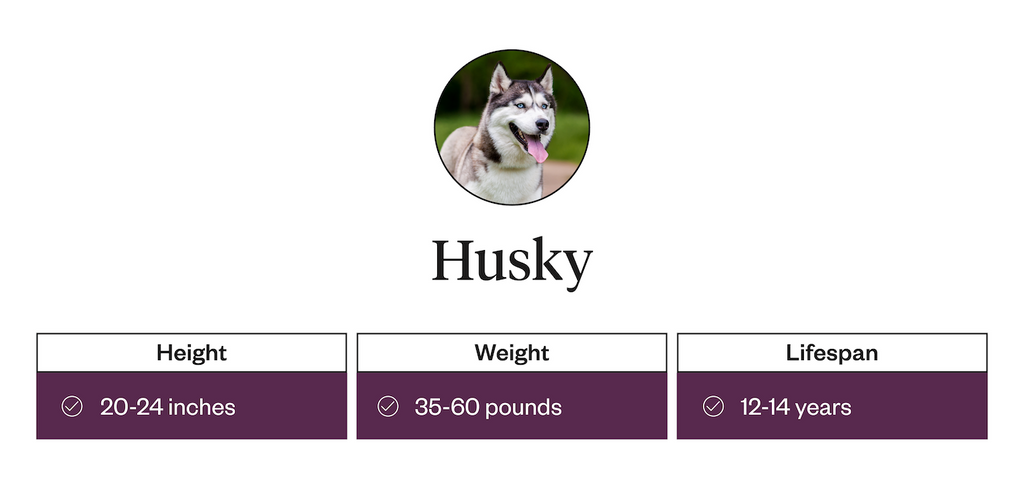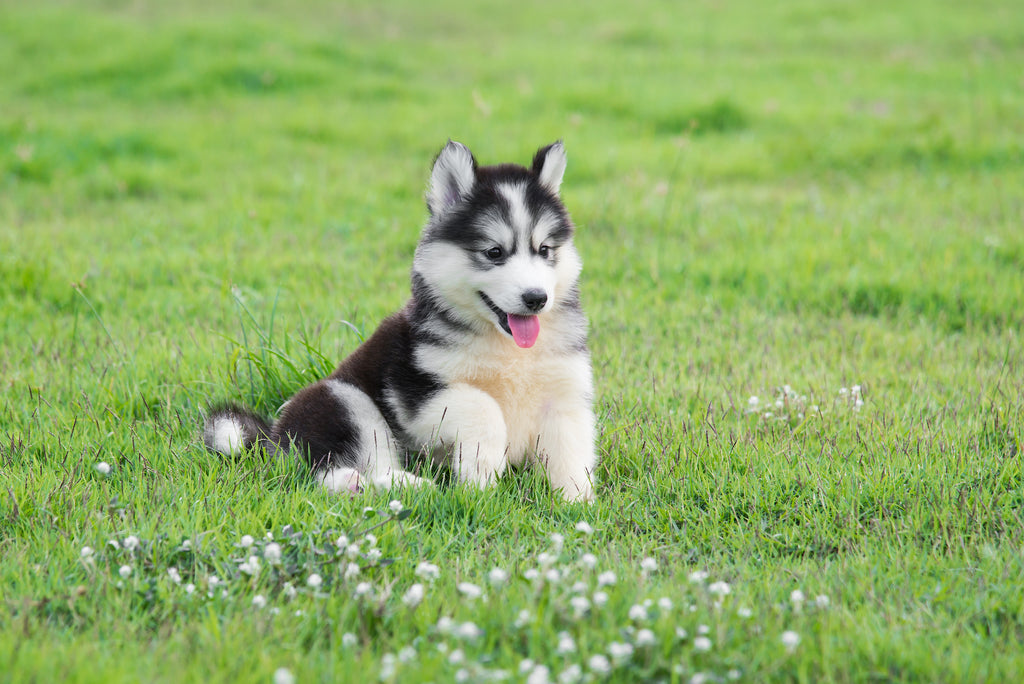9 Min Read
Husky: Pet Profile
Key takeaway

Why pet owners are switching to online vet care with Dutch
-
Prescriptions delivered free to you
-
Fast access to Licensed Vets over video
-
Unlimited video visits and follow-ups
The husky is known for its striking wolf-like appearance, thick double coat, and erect ears. This breed was originally bred for sledding and companionship. As such, they’re resilient, energetic, and enjoy running.
Their friendly and gentle temperament makes them a welcome addition to any household. Paired with their unique appearance, they’re one of the most recognizable breeds worldwide. However, their high energy levels and intelligence mean they require more exercise and mental stimulation than other dogs to stay happy and healthy.
Keep reading to learn more about the winter-loving husky to determine if it’s the right breed for you.
- History & Origin Of Huskies
- Physical Attributes Of Huskies
- Behavioral Characteristics Of Huskies
- Husky Health Risks
- Caring For A Husky
- FAQs
- Final Notes
History & Origin Of Huskies
The Siberian husky is an ancient dog breed that can trace its roots back to the harsh wintery environment of northeastern Asia. These dogs were raised by the Chukchi people.1 They used their dogs for transporting goods over icy terrains, and huskies were known to withstand frigid Arctic temperatures.
Unlike other working breeds, huskies weren’t used for hunting like Plott Hounds and Great Danes. Instead, they had a much simpler but just as necessary purpose: pulling sleds. While they could assist in hunting, they primarily focused on transportation, helping the Chukchi people bring the game back home after it was hunted.
Like Samoyeds, Siberian huskies were originally bred for their strength, endurance, and ability to work well in packs to ensure proper sled pulling. These sled dogs were unknown outside Siberia until around 1908 when they arrived in North America.2
They were imported to Nome, Alaska, by a fur trader named William Goosak for the All Alaska Sweepstakes race in 1909.2 The racing huskies placed third, and rumors of this mysterious breed began to travel. A Scotsman from the Nome race traveled to Siberia that summer and purchased 60 Siberian huskies before entering them in the following year’s All Alaska Sweepstakes race, where they won.2
From there, the Siberian husky dog was bred with other breeds, such as Greyhounds and Alaskan Malamutes, to create the designer dog, the Alaskan husky, to produce the best sledding qualities.
From there, Siberians gained popularity as racing dogs. However, they became heroes in 1925 when Nome experienced an epidemic. The medicine was over 600 miles away, so Leonhard Seppala left Nome with 20 Siberian huskies to get to the serum faster, traveling with his dogs to the Yukon River.2 Alaskan huskies were also part of the team.
Seppala’s sled leader Togo, led the team before another team led by a Siberian named Balto completed the last leg of the journey.2
Seppala left Nome with 40 Siberian huskies, including Togo, and traveled worldwide. Togo was presented with a medal for his role in delivering the serum. From there, Seppala and his team of sled dogs continued to win races before he and Elizabeth Ricker, a musher, established a kennel for the breed.2
At this time, there were no Siberian husky breeders in Alaska until Natalie Jubin in 1946.2 However, people were still breeding them with other dogs, creating the Alaskan husky and various other breeds for racing.
According to the American Kennel Club, the Alaskan husky doesn’t have a breed standard due to its mixed lineage and is not a purebred dog. Today, the Siberian and Alaskan husky are central to sled dog racing and homesteading in Alaska and other cold regions.
Physical Attributes Of Huskies

The Siberian husky dog is a medium-sized working breed that’s quick on its feet. They have a well-balanced and compact body with a deep chest and strong limbs built for endurance and strength. Their ears are medium-sized, triangular, and erect, with a tail that’s carried up in a gentle curve.4
One of the most notable features of the husky is its coat. Siberian huskies have a double coat, making them ideal sled dogs that withstand harsh environments. The undercoat is dense and insulates them from cold weather. On the other hand, the topcoat is straight and medium-length to offer protection from snow and ice.4
Huskies have a variety of coat colors and patterns. The most common colors include black, gray, agouti, red, sable, and pure white.4 Their coats often feature two colors, with one being more dominant and the other being symmetrical or asymmetrical markings.4
Another widely regarded feature of the husky’s appearance is their almond-shaped eyes. Their eyes are blue or brown or have heterochromia, where each eye is a different color, making their appearance even more striking.4
Behavioral Characteristics Of Huskies

Huskies are affectionate with family and others and tend to do well with children.3 Of course, it’s worth noting that every dog is different. Your dog’s temperament will depend on various factors, including early socialization and past experiences, that can influence their behavior.
In general, Siberian huskies are full of energy. Since they were bred for a physical job, you can expect playfulness and high energy levels. You’ll need to provide them with both mental and physical stimulation to keep them happy and healthy.
Additionally, huskies are companion animals that thrive in social settings. They prefer spending time with their human companions and thrive among other pets.3
Huskies are also notably vocal animals.3 They “talk” and howl instead of barking. This trait can be amusing for pet owners, but huskies are not ideal apartment dogs for this reason. Instead, your husky will prefer large spaces where they can release some of their energy and talk the day away.
This breed is also intelligent, which is why many huskies are sled dogs. However, they can be independent thinkers and may be challenging to train.3 This behavior can be perceived as stubbornness, but with quality training, a husky (and every dog, for that matter) can be well-trained.
Huskies can adjust to various living conditions. However, their thick double coats make them most comfortable in cooler climates.
Husky Health Risks
Huskies are purebred dogs, making them more prone to a variety of health issues due to selective breeding. These health issues may include:
- Hip dysplasia: Hip dysplasia is common in Siberian huskies and can lead to severe arthritis later in life. Breeders should avoid breeding dogs with this condition.5
- Epilepsy: Some huskies are prone to seizures, which can be an inherited health condition. Dogs with a history of seizures shouldn’t be bred.5
- Cancer: Huskies may have a predisposition to certain cancers, but there’s no evidence to suggest they’re at higher risk compared to other breeds.
- Eye problems: Huskies may develop eye problems like cataracts as they age. However, they can experience signs of cataracts as young as six months of age.5
- Skin problems: Huskies may experience a range of skin issues due to genetic predispositions, environmental allergens, and dietary issues.
Caring For A Husky
Siberian huskies are known for their resilience and striking appearance. While not technically a “high maintenance dog,” they require proper care to ensure their health and wellness.
Preventive care
Huskies should visit the vet at least once a year for a general wellness exam, vaccinations, and preventive treatments like those against heartworm, fleas, and ticks. During these visits, your vet will check their coat, skin, teeth, eyes, and ears to ensure they’re healthy. This also gives you the opportunity to discuss any concerns directly with your vet.
Grooming
Huskies have a dense double coat that sheds heavily.3 Brushing their coat multiple times a week can help prevent their fur from shedding where you don’t want it, but you can expect to find their fur on clothing and furniture.
While huskies don’t need frequent baths, you should bathe your husky every few months or as needed. At the same time, you should check and clean their paws regularly, especially after walks in the winter when snow, ice, and salt can cause cracked paws and injury. Additionally, you should keep their nails short to prevent injuries when they’re being active. This will also ensure proper paw pad traction when your dog is walking on slippery surfaces like ice or hardwood flooring.
Regular ear cleaning and teeth brushing can also prevent serious issues.
Exercise
Siberian huskies are athletic, high-energy dogs that need both mental and physical stimulation. Since they’re a working breed, they’re happiest when they have a job.3 These dogs were bred to run, so they thrive in homes with fenced-in yards.However, daily vigorous exercise like jogging, hiking, or playing fetch can help them stay fit.
For mental stimulation, consider puzzle toys, obedience, training, and agility courses.
Whatever you choose to do, remember that while huskies are working dogs, they’re also companion pets. Finding activities you and your husky can do together can strengthen your bond. For instance, you can go camping with your dog and allow them to explore new environments while spending quality time together.
Diet and Nutrition
Siberian huskies are loaded with energy, so they need a balanced diet that supports their everyday activities. Choose high-quality dog food for your dog’s life stage. For instance, husky puppies should eat food designed for puppies.
Training And Socialization
All breeds benefit from early socialization that can give them the confidence they need in new situations and environments. Introducing your dog to new people, pets, places, sights, sounds, and smells early on can help reduce anxiety later in life. Training is also crucial for huskies. While they’re highly intelligent, they benefit most from consistent, positive reinforcement training (like most dogs).
FAQs
Are huskies expensive?
Huskies can be expensive to purchase, with husky puppies sold for a few hundred to a thousand dollars or more. Owning a husky also involves other expenses, such as food, vet care, grooming, and other maintenance needs.
Are huskies hard to take care of?
Huskies are high-energy, intelligent dogs that require consistent training, regular exercise, and thorough grooming. While they’re known for their friendly nature, they’re not ideal for first-time pet parents because they tend to be more difficult to care for than some other breeds.
Are huskies good family dogs?
Like all dogs, huskies can be good family dogs with proper socialization, training, and care. They’re typically affectionate and friendly and get along well with children and other pets.

Final Notes
Huskies are a blend of endurance, intelligence, and friendliness. From Arctic origins to our modern homes, their captivating appearance and spirited nature make them excellent companions. While they may come with their set of challenges, they offer an unmatchable bond.
Caring for a husky takes work. Let Dutch help. Keep your adventurous companion in peak health from the comfort of your home. Try Dutch today.
Share
References
-
- “Siberian Husky.” Encyclopædia Britannica, 8 Aug. 2023, www.britannica.com/animal/Siberian-husky.
-
“Siberian Husky History.” Siberian Husky Club of America, Inc, www.shca.org/siberian-husky-history.
-
Kriss, Randa. “Siberian Husky Dog Breed Information.” American Kennel Club, 6 Nov. 2017, www.akc.org/dog-breeds/siberian-husky/.
-
“Siberian Husky Breed Standard.” American Kennel Club, https://images.akc.org/pdf/breeds/standards/SiberianHusky.pdf.
-
“All about Siberian Husky Dogs.” WebMD, 9 Apr. 2022, www.webmd.com/pets/dogs/what-to-know-siberian-huskies.
